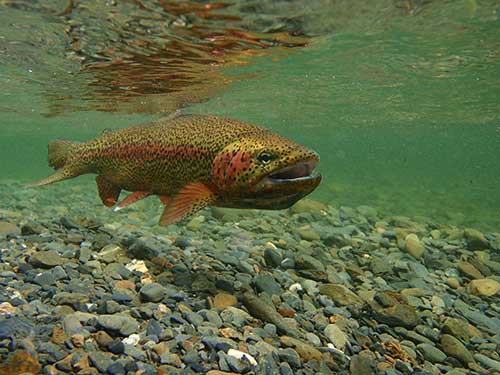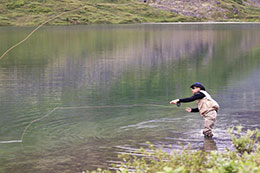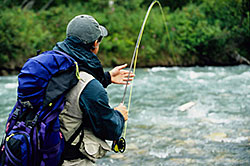Alaska Fish & Wildlife News
September 2013
Rainbow Connections
Fishing for Alaska Rainbows

My very first rainbow trout startled me: It struck hard, wrenching my wrists, my shoulders; it stole my breath and stirred a strange tickle deep in my chest. The fish snatched my bait in the shallows of a famous Alaska river, the Kenai, and ran fast for the deep, swift water in the main channel. My instructions were to sit and not move, no matter what, but to call out should a fish be hooked.
So I held on and cried out to my father who cast for trout from a gravel bar upriver a good, hard shout away. My fishing rod wasn’t much – maybe three feet long, cork-handled, white with red wrap, and rigged with a secondhand, single-action reel that my father had dug from an old box and cleaned of rust and spray-painted red. The outfit was fine for a 5-year-old boy, the rod stout enough to provide the leverage I needed to hold that fish as my father splashed and stumbled across the river to the little slough where he’d left me.
I landed the trout, much to my father’s delight – and to mine – and later a second rainbow trout followed, a three-pound twin of the first. I’ve long lost track of a snapshot recording the event, a print already creased and fading last I saw, taken by my father of his grinning crew-cut kid holding up both fish by the gills.
Enough water has flowed from Alaska’s trout streams over the ensuing 45 years to form an ocean and, in that time, I’ve caught many, many rainbow trout. But the images of that day have never left me. Even today every rainbow trout I catch, large or small, is measured against a time when I was very young and the world was new and everything that happened came as a surprise.
***
The element of surprise is a large part of the rainbow’s allure, particularly in Alaskan waters where the next trout hooked might be a three-pound scrapper, or a heart-stopping heavyweight three feet long. The fish come in two forms here, resident and sea-run, and both grow big. The state record, a sea-run version caught in briny Southeast, weighed 42 pounds, 3 ounces, and stories of resident fish busting the 20-pound threshold are written on our rivers every summer.
Rainbow trout are native to Alaska’s southern third, a roughly California-size hunk of wild lands, streams and lakes spanning a procession of geographies and climate zones from temperate Southeast, north and west to the Susitna Valley, the Kenai Peninsula, and far beyond to the tundra reaches of Bristol Bay, Kodiak Island and the western Alaska Peninsula.
Most common are the resident trout that spend their lives within given stream or lake systems. These may be honey-colored creatures, freckled like leopards, such as those of the tannic brooks and ponds south of the Alaska Range; or flashy chrome-flanked behemoths that lurk among spawning salmon in the great lake systems of Bristol Bay.
Sea-run rainbow trout, called steelhead, are generally found close to the coast where their life cycles mimic those of Pacific salmon. Steelhead spawn and rear in freshwater, but spend several years maturing and growing in saltwater. Once mature, the sea-run rainbows return to natal streams to spawn and the cycle comes full circle. Unlike Pacific salmon, steelhead may recover after spawning to return to the sea and reappear in subsequent years to spawn again.
Steelhead come and go with the tides of spring and fall; anglers seek them in more than 300 Southeast Alaska streams and in others more sparsely distributed north and west around the Gulf of Alaska and ultimately far west toward Cold Bay on the Alaska Peninsula. Steelhead runs in Alaska are generally small, with annual returns ranging from highs of up to 6,000 fish in Yakutat’s Situk River to fewer than a hundred in many smaller systems.
***
To fish for rainbow trout in an Alaskan river at dusk is to tempt a monster. Depending on where you’re fishing – say, a wilderness dream like Southwestern Alaska’s Alagnak; the swift, mountain-clear waters of Southcentral’s Russian; or an evening tide in April on the whiskey-tinted streams of Southeast’s Prince of Wales Island – nighttime here is the venue of 20-pound legends.
At the moment, it’s mid-September and I’m back on the upper Kenai River, not far from the spot where those first rainbows stole my heart 45 long years ago. Everything has fallen quiet now that the sun has dropped for the night behind the Kenai Mountains; everything, that is, except the river. The angling author Roderick Haig-Brown wrote that a river never sleeps, and now, in the late-evening murk, the current’s gushings and gurglings – the sounds of water hustling along, folding against logs and rocks – seem eerily amplified. A chill has crept into the air, and I’m casting my fly rod as much to stay warm as to find a fish.

We started fishing late that day. I’d driven the hundred or so miles south from my home in Anchorage on the scenic Seward and Sterling highways to meet Paul, a friend from my college days, and his 85-year-old father, Pat. By the time we rendezvoused outside the upper Kenai River community of Cooper Landing and loaded up Paul’s pontoon raft, the night’s frosts had dissolved and the usual fleet of anglers in drift boats and rafts had long departed, leaving broad stretches of river to us alone.
The day was brilliant. The sun burned brightly over the mountains as we rode the glacial blue-green Kenai, fishing and watching the world flow by, the hours framed by yellow cottonwood leaves backlit and glowing against powder-blue skies. We caught fish all day long, a few two- and three-pound rainbow trout and many impressive Dolly Varden – red-bellied, pink-spotted char resembling overgrown brook trout – weighing five and six pounds apiece. At one point as we drifted silently along, a brown bear stepped out of the brush and trundled down the shoreline, picking at the scores of dead, spawned-out red salmon that lay helter-skelter at the river’s edge like casualties of an epic battle.
The bear ignored us as we drifted silently past. Powerful muscles rippled beneath its shaggy hide and its long claws clicked like sabers against the shoreline cobbles. For a moment the world seemed a dangerous place where salmon die by the thousands and a monstrous grizzly was king. None among us seemed aware that a monster might be lurking in the water beneath us, too, waiting for nighttime to strike.
***
Alaska’s biggest rainbow trout, fish that eclipse an almost unbelievable 30 inches in length, are most often linked to the state’s great salmon rivers. Because many of the most productive salmon rivers are those fed by great lakes, anglers in search of the world’s largest, most abundant rainbow trout will do no better than the lake-and-river systems of the Bristol Bay region. Here, sockeye, or “red,” salmon return each summer by the millions to rivers draining enormous lakes like Iliamna, Naknek, and Aleknagik. The lakes provide critical rearing habitat for young sockeye, and important wintering water for rainbow trout.
The relationship between salmon and trout works like this: When the salmon return from the Pacific en masse each summer to spawn, the rainbows are waiting. Like wolves following a caribou herd, trout shadow the salmon schools upstream to spawning gravel where they wait to feed on freshly dropped eggs. The salmon eggs are protein-rich and available in abundance throughout the summer and well into the fall. And once the salmon die after spawning, their carcasses litter streambeds to provide more protein-rich provender for meat-hungry trout.
Outside remote Bristol Bay, the easily accessible Kenai River is a major producer of salmon and trophy-size rainbows. The Kenai River drains Kenai and Skilak lakes and hosts annual returns of more than a million sockeye. Large returns of spawning Chinook, pink, and coho salmon also contribute eggs and carcasses to the river, further extending the availability of excellent feed for ravenous rainbows. As a result, nice trout – fish weighing 6 to 8 pounds – are not uncommon in the Kenai. But it’s the truly big fish, the fabled 20-pounders, that make this already famous river even more so among anglers.
Other highly productive and easily reached rainbow trout waters flow through Southcentral’s Susitna River drainage. Anglers who travel the Parks Highway north of Anchorage enjoy banner days fishing the region’s many smaller streams where trout may range from a foot- to two feet long. Lacking the dynamics of the Bristol Bay and Kenai River systems, 30-inch-long fish are all but nonexistent in the Susitna River drainage. Even so, the venue is a Mecca for anglers who enjoy catching two- and three-pound trout all day long –

along with the occasional five- or six-pound lunker – in the very shadow of Mount McKinley.
Highlights of my own summers include days spent prowling the region’s fern-bordered streams, catching and releasing untold hundreds of Susitna Valley beauties, each speckled prize seemingly hand-painted by Mother Nature Herself and sharing a universal rainbow-trout fragrance reminiscent of wild grass, feral water, and pure, fresh, sweet fish.
***
Back on the Kenai it is late and I’m casting into the chilly night more by feel than by sight. Paul has stopped us on a gravel bar a mile or so above Jim’s Landing, our take-out point, in a stretch of water that gallops like an oversized mountain stream.
The fishing for rainbows, steady all day, only improved as the sun sunk low and the trees cast long shadows across the river. I caught a good six-pounder – pot-bellied and strong from a summer salmon-egg diet – that led me first upriver, then down, the fish running deep before charging the surface and leaping again and again. Minutes later, Pat caught and released a pink-flanked trout more than two feet long that weighed maybe seven pounds. It was, remarked the World War II Navy veteran, a man who’s seen just about everything, the biggest rainbow trout of his life.
Fish like that are enough, really, so strong, heavy and fast; they make it hard to imagine that much bigger fish – true monsters – are out there.
But here in Alaska, monster rainbows are out there. And now on the upper Kenai River where nighttime is prime time, it occurred to me those 20-pounders were already sliding into the main current from dark lairs beneath cut-banks and logjams.
Which is why I should have been prepared when it happened.
One moment I was focused on river sounds and the murmurs of Paul and Pat talking in the darkness upstream, the next it seemed my fly rod had been struck by lightning. I had no time to shout, to alert the others that something big was brewing; it was all I could do to hold on, focus, to maintain my composure.
The strike was that of a rainbow, vicious, jarring, but the fish didn’t turn instantly and run as most trout do. Instead, it stayed put and leaned into the current with a startling heaviness. My 8-weight fly rod, stout enough to conquer crazy-fighting sea-bright sockeyes and even the occasional thick-shouldered Chinook, seemed suddenly inadequate. I yanked back on my rod tip to try and move the trout, to get it running so that it might wear itself out.
Then, as in a recurring nightmare I used to have as a young man, the fish turned and lunged straight away. In the dream I would hold on, a giant fish the size of sailboat pulling me in deeper, deeper, until I lost my footing and fell headfirst into darkness.
But this was no dream. The trout gained speed, headed for the fast water in the center of the river. I knew right away that the combination of fish and current was too much. The trout was too heavy and strong, the river too swift. Expensive fly line peeled off my reel. I feared the fish would spool me – run out my entire line and backing, then break off the works with a shake of its head. I was whipped.
Wrapped in the night’s shadows, knee-deep in the surging river, I pointed my rod at the fish and clenched my whirling reel. There was a final tug and my leader popped like thread. The trout was gone.
For a heartbeat or two I simply stood there, overwhelmed by an undeniable rush. I don’t know how much that rainbow would have weighed – 20 pounds? Possibly. More poignant was the sense that I’d recaptured a connection to my past; the thrill I’d known when I was very young and the world very new had returned. It was a bit like growing up and discovering that you actually can go home again. Alaska’s trout streams are powerful that way; every rainbow hooked here, large or small, is a reminder that no matter your age or how long you’ve been fishing, big surprises wait just a cast or two away.
###
Ken Marsh is a free-lance writer and longtime Alaska who makes his home in Anchorage.
Subscribe to be notified about new issues
Receive a monthly notice about new issues and articles.
